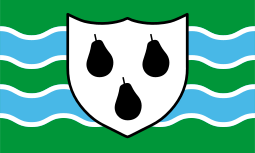Worcester Cathedral
Worcester Cathedral, is an Anglican cathedral in Worcester, England, situated on a bank overlooking the River Severn. It is the seat of the Bishop of Worcester. Its official name is the Cathedral Church of Christ and the Blessed Mary the Virgin, of Worcester. The present cathedral church was built between 1084 and 1504, and represents every style of English architecture from Norman to Perpendicular Gothic. It is famous for its Norman crypt and unique chapter house, its unusual Transitional Gothic bays, its fine woodwork and its "exquisite" central tower,[1] which is of particularly fine proportions.[1][2]
| Worcester Cathedral | |
|---|---|
| Cathedral Church of Christ and the Blessed Mary the Virgin, of Worcester | |
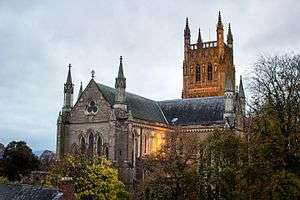 Worcester Cathedral | |
 Worcester Cathedral Location within Worcestershire | |
| Location | Worcester (Worcestershire) |
| Country | United Kingdom |
| Denomination | Church of England |
| Website | worcestercathedral.co.uk |
| History | |
| Former name(s) | Worcester Priory |
| Architecture | |
| Functional status | Active |
| Style | Norman, Gothic |
| Years built | 1084-1504 |
| Specifications | |
| Length | 130 m (426.51 ft) |
| Nave length | 53 m (173.88 ft) |
| Width | 44 m (144.36 ft) |
| Nave width | 9 m (29.53 ft) |
| Nave height | 20 m (65.62 ft) |
| Tower height | 62 m (203.41 ft) |
| Administration | |
| Diocese | Worcester (since 670) |
| Province | Canterbury |
| Clergy | |
| Bishop(s) | John Inge |
| Dean | Peter Atkinson |
| Precentor | Michael Brierley |
| Canon(s) | Georgina Byrne vacant (Theologian) |
| Laity | |
| Organist(s) | James Lancelot (Interim) |
The cathedral's west facade appeared, with a portrait of Sir Edward Elgar, on the reverse of £20 note issued by the Bank of England between 1999 and 2007, remaining in circulation as legal tender until 30 June 2010.[3][4]
History
Early history
The Cathedral was founded in 680, with a Northumbrian priest, Tatwine, appointed as its first bishop. Tatwine died before he could be consecrated, however, so his successor Bishop Bosel may be regarded as Worcester's first serving bishop.[5] The first cathedral church, dedicated to Ss. Peter and Paul, was built in this period, but no remains of its architecture survive. The crypt of the present-day cathedral dates from the 11th century and the time of Wulfstan 'Bishop of Worcester.
The community associated with the cathedral the early eighth century included members of various clerical orders.[6] The cathedral community was regulated along formal monastic lines as a consequence of the Benedictine reforms in the second half of the tenth century (one author gives the time range 974-977, another considers 969 more likely). There is an important connection with Fleury Abbey in France, as Oswald, bishop of Worcester from 961 to 992, was professed at Fleury and introduced the monastic rule of Fleury to the monastery that he established at Worcester around the year 966, which was dedicated — as the present cathedral church is — to St. Mary.[7]
Medieval

The last Anglo-Saxon bishop of Worcester, Wulstan, unusually remained bishop after the Norman Conquest until his death in 1095. He was later made a saint.
It is the burial place of John, King of England, who succeeded his brother Richard I of England.
The Cathedral Priory was a major landowner and economic force, both in Worcester and the county. Its properties for instance included the priory manor of Bromsgrove.[8] It was a centre of learning and provided schooling. It was associated with hospitals. The Church received a portion of local taxations and ecclesiastical law applied to Christian morals and could result in punishments. It had close political associations with leading gentry and aristocracy. As such, Worcester's Cathedral had a central role in the medieval life of the city and county.[9]
The Cathedral was one of a number of religious institutions in the city.[10]
Relations with the Jewish community of Worcester
The Diocese was notably hostile to the small Jewish community which was established in Worcester. Peter of Blois was commissioned by a Bishop of Worcester, probably John of Coutances, to write a significant anti-Judaic treatise Against the Perfidy of Jews around 1190.[11]
William de Blois, as Bishop of Worcester, imposed particularly strict rules on Jews within the diocese in 1219.[12] As elsewhere in England, Jews were officially compelled to wear rectangular white badges, supposedly representing tabulae.[13] In most places, this requirement was relinquished as long as fines were paid. In addition to enforcing the church laws on wearing badges, Blois tried to impose additional restrictions on usury, and wrote to Pope Gregory in 1229 to ask for better enforcement and further, harsher measures. In response, the Papacy demanded that Christians be prevented from working in Jewish homes, "lest temporal profit be preferred to the zeal of Christ", and enforcement of the wearing of badges.[14]
Dissolution and Reformation
The priory came to an end with King Henry VIII's Dissolution of the Monasteries. Shortly beforehand, in 1535, the prior William More resigned, and was replaced by Henry Holbeach. More had a reputation for fine living, although his standards seem in line with other senior ecclesiasts of the time. However, there certainly were problems with the administration of the priory, including divisions within the community.[15]
The Protestant Hugh Latimer was bishop from 1535, and preached for reform and iconoclasm. He resigned as bishop in 1539, as a result of a theological turn by Henry VIII towards Roman Catholicism, in the Six Articles. John Bell, a moderate reformer, was bishop from 1539 to 1543, during the period of the priory's dissolution.
In the early 16th century, Worcester had around 40 monks. This declined slightly in the years immediately before 1540, as recruitment seems to have halted. There were 35 Benedictine monks plus the Prior Holbeach at the time of dissolution, probably 16 January 1540; eleven were immediately given pensions, while the remainder became secular canons in the new Royal College. Holbeach was re-appointed as the first Dean. A further five former monks were pensioned from the college in July 1540.[16]
The former monastic library of Worcester contained a considerable number of manuscripts which are, among other libraries, now scattered over Cambridge, London (British Library), Oxford Bodleian, and the Cathedral library at Worcester of today.[17] Remains of the priory dating from the 12th and 13th centuries can still be seen.
John Bell's successor as Bishop, Nicholas Heath, was religiously much more conservative and Catholic.
Civil War
During the Civil War, the Cathedral was used to store arms, possibly as early as September 1642.[18] Worcester declared itself for the Crown and was quickly occupied by extra Royalist forces,who were using the building to store munitions when Essex briefly retook the city after a skirmish on its outskirts. The Parliamentary troops then ransacked the Cathedral building. Stained glass was smashed and the organ destroyed, along with library books and monuments.[19]
The See was abolished during the Commonwealth and the Protectorate, approximately 1646–60.[20] The belltower was demolished in 1647 and the building used as a prison in the aftermath of the 1651 battle.[21]
Victorian to present
In the 1860s, the cathedral was subject to major restoration work planned by Sir George Gilbert Scott and A. E. Perkins.
An image of the cathedral's west facade appeared on the reverse of the Series E British £20 note commemorating Sir Edward Elgar, issued between 1999 and 2007.[22]
Architecture
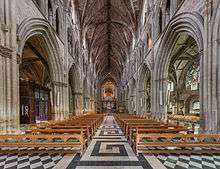
Worcester Cathedral embodies many features that are highly typical of an English medieval cathedral. Like the cathedrals of Salisbury and Lincoln, it has two transepts crossing the nave, rather than the single transept usual on the Continent. This feature of English Cathedrals was to facilitate the private saying of the Holy Office by many clergy or monks. Worcester is also typical of English cathedrals in having a chapter house and cloister. To the north side of the cathedral is an entrance porch, a feature designed to eliminate the draught which, prior to the installation of modern swing doors, would blow through cathedrals whenever the western doors were open.
Worcester Cathedral has important parts of the building dating from every century from the 11th to the 16th. Its tower in the perpendicular style is described by Alec Clifton-Taylor as "exquisite"[1] and is seen best across the River Severn.[2]
The earliest part of the building at Worcester is the multi-columned Norman crypt with cushion capitals remaining from the original monastic church begun by bishop Saint Wulfstan of Worcester in 1084. Also from the Norman period is the circular chapter house of 1120, made octagonal on the outside when the walls were reinforced in the 14th century. The nave was built and rebuilt piecemeal and in different styles by several different architects over a period of 200 years, from 1170 to 1374, some bays being a unique and decorative transition between Norman and Gothic.[1][23] The oldest parts show alternate layers of green sandstone from Highley in Shropshire and yellow Cotswold limestone.[24]
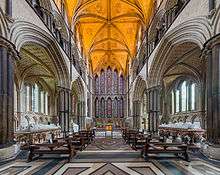

The east end was rebuilt over the Norman crypt by Alexander Mason between 1224 and 1269, coinciding with, and in a very similar Early English style to, Salisbury Cathedral. From 1360, John Clyve finished off the nave, built its vault, the west front, the north porch and the eastern range of the cloister. He also strengthened the Norman chapter house, added buttresses and changed its vault. His masterpiece is the central tower of 1374, originally supporting a timber, lead-covered spire, now gone. Between 1404 and 1432, an unknown architect added the north and south ranges to the cloister, which was eventually closed by the western range by John Chapman, 1435–38. The last important addition is Prince Arthur’s Chantry Chapel to the right of the south choir aisle, 1502–04.[1][23]
Worcester Cathedral was extensively restored from 1857 to 1874 by W. A. Perkins and Sir George Gilbert Scott. Most of the fittings and the stained glass date from this time. Some early 17th century screens and panelling, removed from the choir and organ casing in 1864, are now at Holy Trinity Church, Sutton Coldfield.[25]
Dean and chapter
As of 8 February 2019:[26]
- Dean — Peter Atkinson (since 28 April 2007 installation)
- Canon Precentor — Michael Brierley (since March 2014)[27]
- Diocesan Canon — Georgina Byrne (since 13 September 2009 installation;[28] also Diocesan Director of Ordinands until 2015, and Dean of Women's Ministry 2005–2016)
- Canon Theologian — vacant since November 2018[29]
Burials and memorials
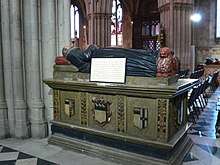


The Cathedral contains the tomb of King John in its chancel. Before his death in Newark in 1216, John had requested to be buried at Worcester. He is buried between the shrines of St Wulstan and St Oswald (now destroyed).
The cathedral has a memorial, Prince Arthur's Chantry, to the young prince Arthur Tudor, who is buried here. Arthur's younger brother and next in line for the throne was Henry VIII. Worcester Cathedral suffered badly from Iconoclasm but was spared total destruction by Henry VIII during the English Reformation because of his brother's chantry in the cathedral.
An epitaph in Latin to Henry Bright, headmaster of the King's School, Worcester, can be found near the north porch.[30] Other notable burials include:
- Godfrey Giffard (c. 1235 – 1302), Chancellor of the Exchequer of England, Lord Chancellor of England, and Bishop of Worcester
- Maud (de Giffard) Devereux (on 3 September 1297), William Devereux’s widow, in a place near the burial site of her brother, Bishop Godfrey de Giffard
- Ivor Atkins (1869–1953), choirmaster and organist at Worcester Cathedral from 1897 to 1950 [31]
- Stanley Baldwin (1867–1947), Prime Minister of the United Kingdom [32]
- Alfred Barry, one time Bishop of Sydney and Primate of Australia [33]
- Ernest Bird (1877–1945), scholar of King's School, Worcester [34]
- Arthur W. Davies (1878–1966), one time Principal of St. John's College, Agra [35]
- Richard Edes (d. 1604), a chaplain to Elizabeth I and James I
- John Gauden (1605–1662), Bishop of Worcester, possible author of the Eikon Basilike[36]
- Philip Goodrich (1929–2001), Bishop of Worcester from 1982 to 1996 [37]
- William Hamilton, 2nd Duke of Hamilton (1616-1651), Scottish Royalist commander
- Sir Thomas Lyttelton, 1st Baronet
- William Henry Reed (1876–1942), violinist, friend and biographer of Edward Elgar [38]
- Robin Woods (1914–1997), Dean of Windsor, Bishop of Worcester from 1971 to 1982 [39]
- Francis Brett Young (1884–1954), Worcestershire author
Library
The Cathedral Library at Worcester, located since the 19th century in the loft above the South Nave, contains nearly 300 medieval manuscripts, 55 incunabula, and 5500 post-medieval printed books. Of particular note are the Worcester Antiphoner (the only book of its kind to survive the Reformation), the will of King John and a 1225 copy of Magna Carta.[40] The large scriptorium at Worcester produced many manuscripts and was a place of work for many famous scribes, such as the chronicler John of Worcester and the unnamed monk identified by his distinctive handwriting as The Tremulous Hand of Worcester.[41]
Misericords
Thirty nine of the misericords date from 1379 and include a complete set of the Labours of the Months. The subject matter includes biblical stories, mythology and folklore including N-07, The Clever Daughter which shows a naked woman draped in a net, riding a goat and carrying a rabbit under her arm. Three of the misericords are Victorian replacements such as N-02, Judas in the jaws of Satan.
Bells
The tower has a ring of twelve bells plus three semitone bells and a non-swinging bourdon.[42] The current peal of 15 ringing bells were cast in 1928 by John Taylor & Co., of Loughborough, from the metal of the original ring cast in 1869. The ring is the sixth heaviest ring of twelve in the world, only the bells in the cathedrals of Liverpool, Exeter, York and St Paul's, London & St Mary Redcliffe church in Bristol are heavier. The bells are also considered to be one of the finest toned rings ever cast. The bells hang in a wooden frame that was constructed in 1869 for the previous ring. Worcester Cathedral is unique in having a purpose-built teaching centre equipped with eight special training bells, linked to computers.[42]
Music


Worcester Cathedral has three choirs: Worcester Cathedral Choir (the principal choir which has both boys' and girls' sections, normally working independently), Worcester Cathedral Voluntary Choir, and Worcester Cathedral Chamber Choir. All three were involved in the BBC broadcast of the midnight and Christmas morning services in 2007, with the boys and the girls of the Cathedral Choir, respectively, taking the lead in the two services.[43] Since the 18th century, Worcester Cathedral Choir has taken part in the Three Choirs Festival, the oldest music festival in the world.
The composer Edward Elgar spent most of his life in Worcestershire. The first performance of the revised version of his Enigma Variations – the version usually performed – took place at the cathedral during the 1899 Three Choirs Festival. He is commemorated in a stained glass window which contains his portrait.
Worcester Cathedral has a long history of organs dating back to at least 1417. There have been many re-builds and new organs in the intervening period, including work by Thomas Dallam, William Hill and most famously Robert Hope-Jones in 1896. The Hope-Jones organ was heavily re-built in 1925 by Harrison & Harrison, and then regular minor works kept it in working order until Wood Wordsworth and Co. were called in 1978. It was a large four-manual organ with 61 speaking stops. It had a large Gothic Revival case with heavily decorated front pipes as well as two smaller cases either side of the quire.[44]
This organ (apart from the large transept case and pedal pipes) was removed in 2006 in order to make way for a new instrument by Kenneth Tickell, which was completed in the summer of 2008.[45] The nave has a separate three-manual Rodgers organ.[46]
Notable organists at Worcester have included Thomas Tomkins (from 1596), Hugh Blair (from 1895), Ivor Atkins (from 1897) and David Willcocks (from 1950). From 2012-2018 the Director of Music and Organist was Peter Nardone.
Events
Worcester Cathedral is the host of the annual graduation ceremonies for the University of Worcester. These ceremonies are presided over by the vice chancellor of the university, and take place over four days in November.[47]
Since 2018 Worcester Cathedral became the host to the annual Honours celebration of the Royal Life Saving Society UK, celebrating the long service and meritous achievements of their lifesaving members.
Gallery
 College Green
College Green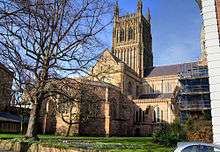 View of the cathedral from College Green
View of the cathedral from College Green Worcester and River Severn
Worcester and River Severn Quire organ cases and decorative ceiling
Quire organ cases and decorative ceiling The rood screen, nave and west window
The rood screen, nave and west window- The altar area
- The high altar
- Painted ceiling
- Statues above the portal
..jpg) 1836 Cathedral floorplan
1836 Cathedral floorplan Taken from the choir
Taken from the choir
See also
References
- Clifton-Taylor 1967
- Tim Tatton-Brown and John Crook, The English Cathedral
- "The Elgar notes are being withdrawn under authority given to the Bank by virtue of Section 1 (5) of the Currency and Banknotes Act 1954. The Elgar £20 banknote was first issued on 22 June 1999. Bank of England - News Release - Withdrawal of Elgar £20 Note" (PDF). Bank of England. 2010. Archived (PDF) from the original on 15 August 2016.
- "£20 Sir Edward Elgar (Introduction 22.06.1999 - Withdrawal 30.06.2010)". Withdrawn bank notes. Bank of England. Archived from the original on 29 July 2016.
- Barrow 2013 electronic edition, loc. 22608
- Barrow 2013, electronic edition, loc. 22614
- Barrow 2013 electronic edition electronic edition, loc. 22626 and 22638; Knowles & Hadcock 1971, p. 81; Braunfels 1972, p. 154
- Dyer 2000
- Willis-Bund & Page 1971a
- Willis-Bund & Page 1971a; Willis-Bund & Page 1971b; Willis-Bund & Page 1971c
- de Blois 1194, Lazare 1903
- Vincent 1994, p. 217
- "Jewish Badge". www.jewishvirtuallibrary.org. Archived from the original on 6 November 2018. Retrieved 20 September 2018.
- Vincent 1994, p. 209
- Thornton 2018, pp. 7–8
- Thornton 2018
- Ker 1964, pp. 205–215
- Atkin 2004, p. 50
- Atkin 2004, pp. 52–53
- King 1968, pp. 523–537
- Atkin 2004, pp. 52–53 and Atkin 2004, p. 133
- "Current Banknotes: Old-style £20 Note (Sir Edward Elgar)". Bank of England. Archived from the original on 29 October 2008. Retrieved 30 October 2008.
- John Harvey, English Cathedrals
- "The Normans: A walk around Worcester Cathedral". BBC Online. 2 August 2010. Archived from the original on 15 June 2013. Retrieved 8 August 2010.
- Historic England. "Details from listed building database (1319961)". National Heritage List for England. Retrieved 27 August 2013.
- Worcester Cathedral — About Us Archived 20 December 2017 at the Wayback Machine (Accessed 8 February 2019)
- "Canon Precentor of Worcester Cathedral: Reverend Michael William Brierley". Prime Minister's Office, 10 Downing Street. Archived from the original on 18 February 2014. Retrieved 16 December 2013.
- "Diocese of Worcester - Press Releases". 24 July 2013. Retrieved 19 February 2018.
- "Archived copy" (PDF). Archived (PDF) from the original on 9 February 2019. Retrieved 8 February 2019.CS1 maint: archived copy as title (link)
- Anna Sander (18 August 1993). "Balliol Gazetteer". Archives.balliol.ox.ac.uk. Archived from the original on 3 October 2011. Retrieved 8 October 2016.
- "File:Worcester Cathedral UK, Sir Ivor Atkins.jpg - Wikimedia Commons". Commons.wikimedia.org. 4 October 2015. Archived from the original on 9 October 2016. Retrieved 8 October 2016.
- "File:Worcester Cathedral Baldwin of Bewdley grave.jpg - Wikimedia Commons". Commons.wikimedia.org. 15 July 2015. Archived from the original on 9 October 2016. Retrieved 8 October 2016.
- "File:Worcester Cathedral UK 16052015 Bishop Alfred Barry.jpg - Wikimedia Commons". Commons.wikimedia.org. 16 May 2015. Archived from the original on 9 October 2016. Retrieved 8 October 2016.
- "File:Worcester Cathedral UK, Sir Ernest Bird.jpg - Wikimedia Commons". Commons.wikimedia.org. 4 October 2015. Archived from the original on 9 October 2016. Retrieved 8 October 2016.
- "File:Worcester Cathedral UK 16052015 Davies Agra.jpg - Wikimedia Commons". Commons.wikimedia.org. 16 May 2015. Archived from the original on 9 October 2016. Retrieved 8 October 2016.
- "The 'Eikon Basilikie' and how to climb a 17th Career Ladder | Worcester Cathedral Library and Archive Blog". Worcestercathedrallibrary.wordpress.com. 19 August 2014. Archived from the original on 13 October 2016. Retrieved 8 October 2016.
- "File:Worcester Cathedral UK 16052015 Bishop Philip Goodrich.jpg - Wikimedia Commons". Commons.wikimedia.org. 16 May 2015. Archived from the original on 9 October 2016. Retrieved 8 October 2016.
- "File:Worcester Cathedral UK, William Henry Reed.jpg - Wikimedia Commons". Commons.wikimedia.org. 4 October 2015. Archived from the original on 9 October 2016. Retrieved 8 October 2016.
- "File:Worcester Cathedral UK 16052015 Bishop Robin Woods.jpg - Wikimedia Commons". Commons.wikimedia.org. 16 May 2015. Archived from the original on 10 October 2016. Retrieved 8 October 2016.
- About Worcester Cathedral Library Archived 20 August 2014 at the Wayback Machine Retrieved 19 August 2014
- Thomson, R. M. (2001). A Descriptive Catalogue of the Medieval Manuscripts in Worcester Cathedral Library (First ed.). Woodbridge: D. S. Brewer. pp. xvii–xlvii. ISBN 978-0859916189.
- Worcester Cathedral church bells Archived 18 October 2008 at the Wayback Machine Retrieved 4 July 2009
- "BBC will broadcast Christmas services live from Worcester Cathedral". 14 November 2007. Archived from the original on 1 October 2012. Retrieved 28 December 2010.
- "Worcester Cathedral". National Pipe Organ Register (NPOR). Retrieved 27 December 2007.
- The specification and drawings were on Kenneth Tickell's website.
- "Rodgers UK ► a tradition of excellence in classical organs". 11 March 2005. Retrieved 20 September 2018.
- "Graduation 2015 - University of Worcester". Worcester.ac.uk. 28 June 2016. Archived from the original on 14 October 2016. Retrieved 8 October 2016.
Sources and further reading
General
- John Noake (1866), The monastery and cathedral of Worcester., London: Longman, OL 7145051M
- Thomas Dingley (1867), History from marble., [Westminster]: Printed for the Camden Society, LCCN 17001261, OL 14133074M
- Worcester Cathedral (official guidebook), Scala Publishers Ltd. (2004) ISBN 1-85759-347-2
- Tatton-Brown, Tim; John Crook (2002). The English Cathedral. New Holland Publishers. ISBN 978-1-84330-120-2.CS1 maint: ref=harv (link)
- R.K. Morris, ed. Medieval Art and Architecture at Worcester Cathedral, 1978
- Clifton-Taylor, Alec (1967). The Cathedrals of England (2nd ed.). Thames and Hudson Ltd. ISBN 978-0500200629.CS1 maint: ref=harv (link)
- Pevsner, Nikolaus; Brookes, Alan (2007), "Worcester: Cathedral Church of Christ and the Blessed Virgin Mary", Worcestershire, The Buildings of England (Revised ed.), London: Yale University Press, pp. 672–702, ISBN 9780300112986, OL 10319229MCS1 maint: ref=harv (link)
Medieval
- Willis-Bund, JW; Page, William, eds. (1971a). "Houses of Benedictine monks: Priory of St Mary, Worcester". A History of the County of Worcester: Volume 2. London: British History Online. pp. 94–112. Retrieved 17 June 2018.CS1 maint: ref=harv (link)}
- Willis-Bund, J W; Page, William, eds. (1971b). "Hospitals: Worcester". A History of the County of Worcester: Volume 2. London: British History Online. pp. 175–179. Retrieved 20 May 2018.CS1 maint: ref=harv (link)
- Willis-Bund, J W; Page, William, eds. (1971c). "Friaries: Worcester". A History of the County of Worcester: Volume 2. London: British History Online. pp. 167–173. Retrieved 13 May 2018.CS1 maint: ref=harv (link)
- Ker, Neil Ripley, ed. (1964). Medieval Libraries of Great Britain. Royal Historical Society. pp. 205–215.CS1 maint: ref=harv (link)
- Vincent, Nicholas (1994). "Two Papal Letters on the Wearing of the Jewish Badge, 1221 and 1229". Jewish Historical Studies. 34: 209–24. JSTOR 29779960.CS1 maint: ref=harv (link)
- Mundill, Robin R (2002). England's Jewish Solution: Experiment and Expulsion, 1262-1290. Cambridge University Press. ISBN 978-0-521-52026-3.CS1 maint: ref=harv (link)
- de Blois, Peter (1194). "Against the Perfidy of the Jews". Medieval Sourcebook. University of Fordham.
A treatise addressed to John Bishop of Worcester, probably John of Coutances who held that See, 1194-8.
CS1 maint: ref=harv (link) - Lazare, Bernard (1903), Antisemitism, its history and causes., New York: The International library publishing co., LCCN 03015369, OCLC 3055229, OL 7137045MCS1 maint: ref=harv (link)
- Barrow, Julia (2013). "Worcester". In Lapidge, Michael; Blair, John; Keynes, Simon; Scragg, Donald (eds.). The Wiley Blackwell Encyclopedia of Anglo-Saxon England. Wiley-Blackwell. ISBN 978-0470656327.CS1 maint: ref=harv (link)
- Knowles, David; Hadcock, R. Neville (1971). Medieval Religious Houses: England & Wales. Longman. ISBN 978-0-582-11230-8.CS1 maint: ref=harv (link)
- Braunfels, Wolfgang (1972). Monasteries of Western Europe. Thames and Hudson. ISBN 978-0-691-00313-9.CS1 maint: ref=harv (link)
- Dyer, Christopher (2000). Bromsgrove: a small town in Worcestershire in the Middle Ages. Occasional Publications. 9. Worcestershire Historical Society. ISSN 0140-9913.CS1 maint: ref=harv (link)
Dissolution and Civil War
- Thornton, David E (2018). "The Last Monks of Worcester Cathedral Priory" (PDF). Midland History. Routledge. 43 (1): 3–21. doi:10.1080/0047729X.2018.1461774. hdl:11693/50072.CS1 maint: ref=harv (link)
- More, William (1914), Fegan, Ethel S (ed.), Journal of Prior William More., London: Printed for the Worcestershire Historical Society, by M. Hughes and Clarke, OL 23307603M
- Atkin, Malcolm (2004). Worcestershire under arms. Barnsley: Pen and Sword. ISBN 978-1-84415-072-4. OL 11908594M.CS1 maint: ref=harv (link)
- King, Peter (July 1968). "The Episcopate during the Civil Wars, 1642–1649". The English Historical Review. Oxford University Press. 83 (328): 523–537. doi:10.1093/ehr/lxxxiii.cccxxviii.523. JSTOR 564164.CS1 maint: ref=harv (link)
External links
| Wikimedia Commons has media related to Worcester Cathedral. |
- Worcester Cathedral official web site. Retrieved 3 June 2009
- Worcester Cathedral at Skyscrapernews.com
- A history of the choristers of Worcester Cathedral
- Adrian Fletcher’s Paradoxplace – Worcester Cathedral Pages – Photos
- Flickr images tagged Worcester Cathedral
- The Worcester Cathedral Chamber Choir
